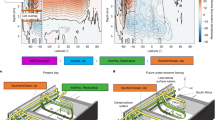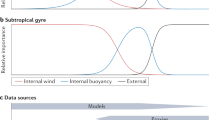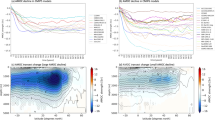Abstract
The degree to which the Atlantic meridional overturning circulation (AMOC) weakens over the twenty-first century varies widely across climate models, with some predicting substantial weakening. Here we show that this uncertainty can be greatly reduced by using a thermal-wind expression that relates the AMOC strength to the meridional density difference and the overturning depth in the Atlantic. This expression captures the intermodel spread in AMOC weakening, with most of the spread arising from overturning depth changes. The overturning depth also establishes a crucial link between the present-day and future AMOC strength. Climate models with a stronger and deeper present-day overturning tend to predict larger weakening and shoaling under warming because the present-day North Atlantic is less stratified, allowing for a deeper penetration of surface buoyancy flux changes, larger density changes at depth and, consequently, larger AMOC weakening. By incorporating observational constraints, we conclude that the AMOC will experience limited weakening of about 3–6 Sv (about 18–43%) by the end of this century, regardless of emissions scenario. These results indicate that the uncertainty in twenty-first-century AMOC weakening and the propensity to predict substantial AMOC weakening can be attributed primarily to climate model biases in accurately simulating the present-day ocean stratification.
This is a preview of subscription content, access via your institution
Access options
Access Nature and 54 other Nature Portfolio journals
Get Nature+, our best-value online-access subscription
$32.99 / 30 days
cancel any time
Subscribe to this journal
Receive 12 print issues and online access
$259.00 per year
only $21.58 per issue
Buy this article
- Purchase on SpringerLink
- Instant access to full article PDF
Prices may be subject to local taxes which are calculated during checkout





Similar content being viewed by others
Data availability
We thank the climate modelling groups for producing and making available their model output, which is accessible on the Earth System Grid Federation (ESGF) Portal (https://esgf-node.llnl.gov/search/cmip6/).
Code availability
The code needed to calculate the overturning depth scale is available on Zenodo at https://doi.org/10.5281/zenodo.15103083 (ref. 53).
References
Schmittner, A., Latif, M. & Schneider, B. Model projections of the North Atlantic thermohaline circulation for the 21st century assessed by observations. Geophys. Res. Lett. 32 (2005).
Cheng, W., Chiang, J. C. & Zhang, D. Atlantic meridional overturning circulation (AMOC) in CMIP5 models: RCP and historical simulations. J. Clim. 26, 7187–7197 (2013).
Reintges, A., Martin, T., Latif, M. & Keenlyside, N. S. Uncertainty in twenty-first century projections of the Atlantic meridional overturning circulation in CMIP3 and CMIP5 models. Clim. Dyn. 49, 1495–1511 (2017).
Weijer, W., Cheng, W., Garuba, O. A., Hu, A. & Nadiga, B. CMIP6 models predict significant 21st century decline of the Atlantic meridional overturning circulation. Geophys. Res. Lett. 47, e2019GL086075 (2020).
Buckley, M. W. & Marshall, J. Observations, inferences, and mechanisms of the Atlantic meridional overturning circulation: a review. Rev. Geophys. 54, 5–63 (2016).
Ganachaud, A. & Wunsch, C. Large-scale ocean heat and freshwater transports during the World Ocean Circulation Experiment. J. Clim. 16, 696–705 (2003).
Zhang, R. & Delworth, T. L. Impact of Atlantic multidecadal oscillations on India/Sahel rainfall and Atlantic hurricanes. Geophys. Res. Lett. 33 (2006).
Zhang, R. et al. A review of the role of the Atlantic meridional overturning circulation in Atlantic multidecadal variability and associated climate impacts. Rev. Geophys. 57, 316–375 (2019).
Mahajan, S., Zhang, R. & Delworth, T. L. Impact of the Atlantic meridional overturning circulation (AMOC) on Arctic surface air temperature and sea ice variability. J. Clim. 24, 6573–6581 (2011).
Day, J. J., Hargreaves, J., Annan, J. & Abe-Ouchi, A. Sources of multi-decadal variability in Arctic sea ice extent. Environ. Res. Lett. 7, 034011 (2012).
Frierson, D. M. et al. Contribution of ocean overturning circulation to tropical rainfall peak in the Northern Hemisphere. Nat. Geosci. 6, 940–944 (2013).
Schneider, T., Bischoff, T. & Haug, G. H. Migrations and dynamics of the intertropical convergence zone. Nature 513, 45–53 (2014).
Marshall, J., Donohoe, A., Ferreira, D. & McGee, D. The ocean’s role in setting the mean position of the Inter-Tropical Convergence Zone. Clim. Dyn. 42, 1967–1979 (2014).
Yin, J., Griffies, S. M. & Stouffer, R. J. Spatial variability of sea level rise in twenty-first century projections. J. Clim. 23, 4585–4607 (2010).
Gregory, J. M. et al. The Flux-Anomaly-Forced Model Intercomparison Project (FAFMIP) contribution to CMIP6: investigation of sea-level and ocean climate change in response to CO2 forcing. Geosci. Model Dev. 9, 3993–4017 (2016).
Saenko, O. A., Yang, D. & Myers, P. G. Response of the North Atlantic dynamic sea level and circulation to Greenland meltwater and climate change in an eddy-permitting ocean model. Clim. Dyn. 49, 2895–2910 (2017).
Vellinga, M. & Wood, R. A. Impacts of thermohaline circulation shutdown in the twenty-first century. Clim. Change 91, 43–63 (2008).
Jackson, L. et al. Global and European climate impacts of a slowdown of the AMOC in a high resolution GCM. Clim. Dyn. 45, 3299–3316 (2015).
Liu, W., Fedorov, A. V., Xie, S.-P. & Hu, S. Climate impacts of a weakened Atlantic meridional overturning circulation in a warming climate. Sci. Adv. 6, eaaz4876 (2020).
Eyring, V. et al. Overview of the Coupled Model Intercomparison Project Phase 6 (CMIP6) experimental design and organization. Geosci. Model Dev. 9, 1937–1958 (2016).
Gregory, J. et al. A model intercomparison of changes in the Atlantic thermohaline circulation in response to increasing atmospheric CO2 concentration. Geophys. Res. Lett. 32 (2005).
Gregory, J. M. & Tailleux, R. Kinetic energy analysis of the response of the Atlantic meridional overturning circulation to CO2-forced climate change. Clim. Dyn. 37, 893–914 (2011).
Weaver, A. J. et al. Stability of the Atlantic meridional overturning circulation: a model intercomparison. Geophys. Res. Lett. 39 (2012).
Kostov, Y., Armour, K. C. & Marshall, J. Impact of the Atlantic meridional overturning circulation on ocean heat storage and transient climate change. Geophys. Res. Lett. 41, 2108–2116 (2014).
Winton, M. et al. Has coarse ocean resolution biased simulations of transient climate sensitivity? Geophys. Res. Lett. 41, 8522–8529 (2014).
Lin, Y.-J., Rose, B. E. & Hwang, Y.-T. Mean state AMOC affects AMOC weakening through subsurface warming in the Labrador Sea. J. Clim. 36, 3895–3915 (2023).
Hall, A., Cox, P., Huntingford, C. & Klein, S. Progressing emergent constraints on future climate change. Nat. Clim. Change 9, 269–278 (2019).
Jackson, L. & Petit, T. North Atlantic overturning and water mass transformation in CMIP6 models. Clim. Dyn. 60, 2871–2891 (2023).
De Boer, A. M., Gnanadesikan, A., Edwards, N. R. & Watson, A. J. Meridional density gradients do not control the Atlantic overturning circulation. J. Phys. Oceanogr. 40, 368–380 (2010).
Nayak, M. S., Bonan, D. B., Newsom, E. R. & Thompson, A. F. Controls on the strength and structure of the Atlantic meridional overturning circulation in climate models. Geophys. Res. Lett. 51, e2024GL109055 (2024).
Spall, M. A. Boundary currents and watermass transformation in marginal seas. J. Phys. Oceanogr. 34, 1197–1213 (2004).
Buckley, M. W., Lozier, M. S., Desbruyères, D. & Evans, D. G. Buoyancy forcing and the subpolar Atlantic meridional overturning circulation. Phil. Trans. R. Soc. A 381, 20220181 (2023).
Nikurashin, M. & Vallis, G. A theory of the interhemispheric meridional overturning circulation and associated stratification. J. Phys. Oceanogr. 42, 1652–1667 (2012).
Jansen, M. F., Nadeau, L.-P. & Merlis, T. M. Transient versus equilibrium response of the ocean’s overturning circulation to warming. J. Clim. 31, 5147–5163 (2018).
Sigmond, M., Fyfe, J. C., Saenko, O. A. & Swart, N. C. Ongoing AMOC and related sea-level and temperature changes after achieving the Paris targets. Nat. Clim. Change 10, 672–677 (2020).
Bonan, D. B., Thompson, A. F., Newsom, E. R., Sun, S. & Rugenstein, M. Transient and equilibrium responses of the Atlantic overturning circulation to warming in coupled climate models: the role of temperature and salinity. J. Clim. 35, 5173–5193 (2022).
Johnson, H. L., Marshall, D. P. & Sproson, D. A. Reconciling theories of a mechanically driven meridional overturning circulation with thermohaline forcing and multiple equilibria. Clim. Dyn. 29, 821–836 (2007).
Forget, G. et al. ECCO version 4: an integrated framework for non-linear inverse modeling and global ocean state estimation. Geosci. Model Dev. 8, 3071–3104 (2015).
Cunningham, S. A. et al. Temporal variability of the Atlantic meridional overturning circulation at 26.5° N. Science 317, 935–938 (2007).
Liu, W., Xie, S.-P., Liu, Z. & Zhu, J. Overlooked possibility of a collapsed Atlantic meridional overturning circulation in warming climate. Sci. Adv. 3, e1601666 (2017).
Boers, N. Observation-based early-warning signals for a collapse of the Atlantic meridional overturning circulation. Nat. Clim. Change 11, 680–688 (2021).
Ditlevsen, P. & Ditlevsen, S. Warning of a forthcoming collapse of the Atlantic meridional overturning circulation. Nat. Commun. 14, 4254 (2023).
Chen, X. & Tung, K.-K. Evidence lacking for a pending collapse of the Atlantic meridional overturning circulation. Nat. Clim. Change 14, 40–42 (2024).
Hofmann, M. & Rahmstorf, S. On the stability of the Atlantic meridional overturning circulation. Proc. Natl Acad. Sci. USA 106, 20584–20589 (2009).
Mecking, J., Drijfhout, S., Jackson, L. & Andrews, M. The effect of model bias on Atlantic freshwater transport and implications for AMOC bi-stability. Tellus A 69, 1299910 (2017).
Van Westen, R. M. & Dijkstra, H. A. Persistent climate model biases in the Atlantic Ocean’s freshwater transport. Ocean Sci. 20, 549–567 (2024).
Lenaerts, J. T. et al. Representing Greenland ice sheet freshwater fluxes in climate models. Geophys. Res. Lett. 42, 6373–6381 (2015).
Bakker, P. et al. Fate of the Atlantic meridional overturning circulation: strong decline under continued warming and Greenland melting. Geophys. Res. Lett. 43, 12–252 (2016).
He, J., Winton, M., Vecchi, G., Jia, L. & Rugenstein, M. Transient climate sensitivity depends on base climate ocean circulation. J. Clim. 30, 1493–1504 (2017).
Newsom, E., Zanna, L. & Gregory, J. Background pycnocline depth constrains future ocean heat uptake efficiency. Geophys. Res. Lett. 50, e2023GL105673 (2023).
McDougall, T. J. & Barker, P. M. Getting started with TEOS-10 and the Gibbs Seawater (GSW) Oceanographic Toolbox. Scor/Iapso WG 127, 1–28 (2011).
Marshall, J., Adcroft, A., Hill, C., Perelman, L. & Heisey, C. A finite-volume, incompressible Navier Stokes model for studies of the ocean on parallel computers. J. Geophys. Res. Oceans 102, 5753–5766 (1997).
Bonan, D. B. et al. Code & data to accompany “Observational constraints imply limited future Atlantic meridional overturning circulation weakening”. Zenodo https://doi.org/10.5281/zenodo.15103083 (2025).
Acknowledgements
This work was supported by the National Science Foundation (NSF) Graduate Research Fellowship Program under NSF Award DGE1745301 (D.B.B.), the Cooperative Institute for Climate, Ocean, and Ecosystem Studies (CICOES) under NOAA Cooperative Agreement NA20OAR4320271, Contribution No. 2025-1450 (D.B.B.), the David and Lucile Packard Foundation and NSF Award OCE-1756956 (A.F.T.), Schmidt Sciences, LLC (T.S. and L.Z.), and NSF Awards OCE-1850900 and AGS-1752796 (K.C.A.).
Author information
Authors and Affiliations
Contributions
D.B.B. conceived of the project, conducted the analysis, generated the figures and wrote the paper. A.F.T. and T.S. contributed to paper revision and supervised the project. L.Z. and K.C.A. contributed to paper revision and helped interpret results. S.S. contributed to project design and paper revision and helped interpret results.
Corresponding author
Ethics declarations
Competing interests
The authors declare no competing interests.
Peer review
Peer review information
Nature Geoscience thanks Wei Cheng and Yen-Ting Hwang and the other, anonymous, reviewer(s) for their contribution to the peer review of this work. Primary Handling Editor: James Super, in collaboration with the Nature Geoscience team.
Additional information
Publisher’s note Springer Nature remains neutral with regard to jurisdictional claims in published maps and institutional affiliations.
Extended data
Extended Data Fig. 1 Comparison of the AMOC weakening calculated in GCMs and predicted by Eq. (3).
Bar plots showing the residual error between the AMOC weakening calculated in GCMs and predicted by the thermal- wind expression (Eq. 3) for each emission scenario at years 2071–2100.
Extended Data Fig. 2 Contributions of each variable to the intermodel spread in Term B from Eq. (3).
The implied AMOC strength change from Term B at years 2071–2100 of the SSP5-8.5 emission scenario. Each panel shows the magnitude of Term B for each GCM when considering the full intermodel spread of all terms (〈Δyρ〉, H, δH) and from H, δH, and (〈Δyρ〉 separately).
Extended Data Fig. 3 Observed present-day AMOC strength implied by ECCO and the RAPID array.
The present-day annual-mean AMOC strength calculated from ECCO and RAPID array at 26.5∘N. The ECCO period is 1992–2017. The RAPID array period is 2005–2021.
Rights and permissions
Springer Nature or its licensor (e.g. a society or other partner) holds exclusive rights to this article under a publishing agreement with the author(s) or other rightsholder(s); author self-archiving of the accepted manuscript version of this article is solely governed by the terms of such publishing agreement and applicable law.
About this article
Cite this article
Bonan, D.B., Thompson, A.F., Schneider, T. et al. Observational constraints imply limited future Atlantic meridional overturning circulation weakening. Nat. Geosci. 18, 479–487 (2025). https://doi.org/10.1038/s41561-025-01709-0
Received:
Accepted:
Published:
Issue date:
DOI: https://doi.org/10.1038/s41561-025-01709-0
This article is cited by
-
Controls of the global overturning circulation of the ocean
npj Climate and Atmospheric Science (2025)
-
Progress and future directions in constraining uncertainties in sea-level projections using observations
Nature Climate Change (2025)



